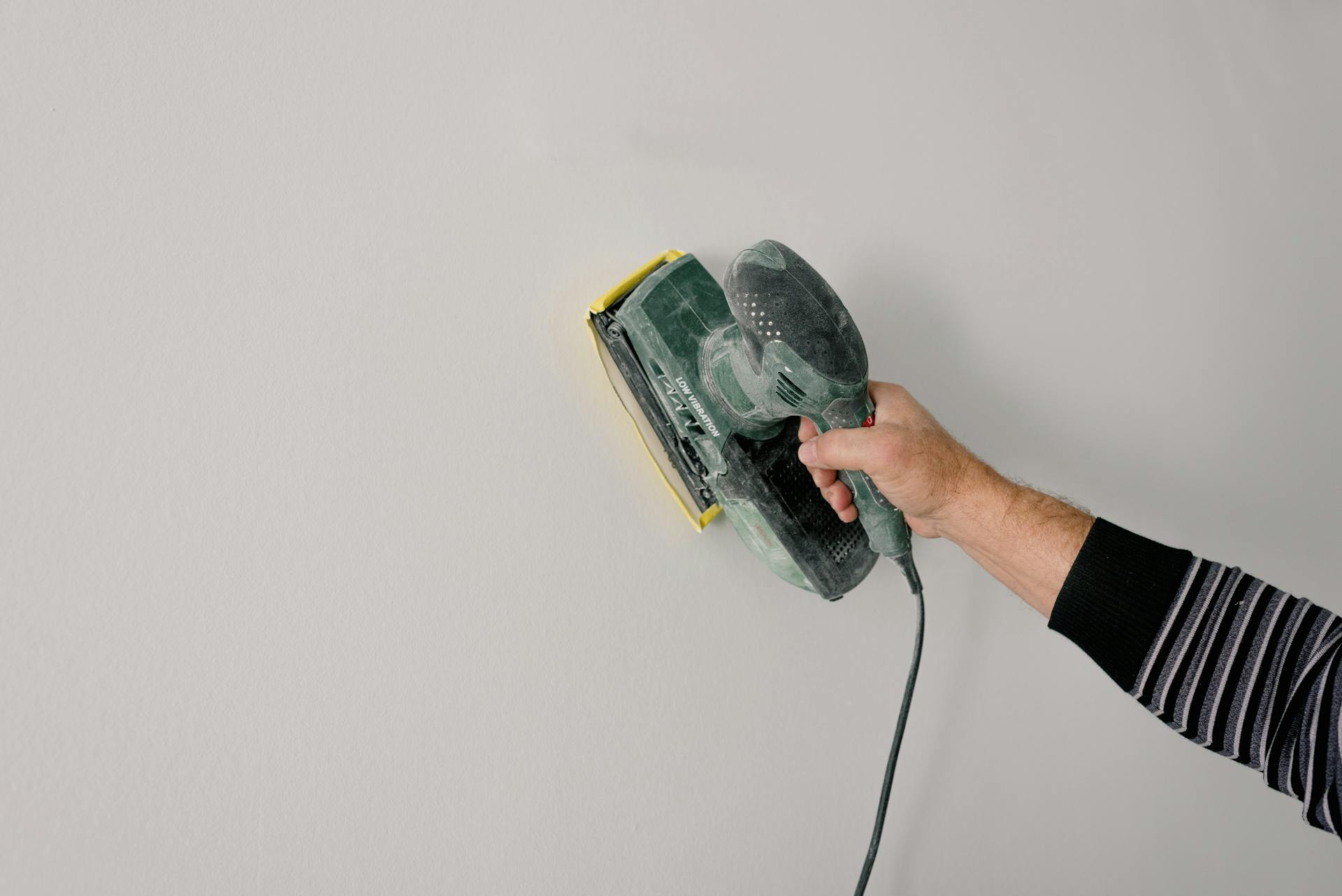
You can use a home equity line of credit (HELOC) to tap into your home's equity, but there are some restrictions you should be aware of.
HELOCs typically have a draw period, which can last from 5 to 10 years, depending on the lender and the loan terms.
During this time, you can borrow and repay funds as needed, but you'll need to make minimum payments on your outstanding balance.
Some lenders may also have a minimum draw requirement, which means you'll need to borrow a certain amount within the draw period to avoid fees.
Discover more: What Documents Do You Need to Get a Heloc
What Is It?
A Home Equity Line of Credit, or HELOC, is essentially a credit balance given to you by your lender, based on a part of your home's equity.
This credit balance can be used like a credit card for about 10 years, allowing you to spend it as needed.
Most HELOCs have a standard variable rate, but some lenders may offer fixed-rate options.
Your lender gives you a credit balance equal to part of your equity, making it a game-changing asset for homeowners.
Using a HELOC
Using a HELOC requires careful consideration of your financial situation. You should avoid using a HELOC for luxury purchases, speculative investments, or high-risk ventures.
To use a HELOC effectively, calculate your estimated equity before applying, and make both interest- and principal-based payments during the draw period. This will help you avoid paying off the entire principal balance in the repayment period.
Here are some dos and don'ts to keep in mind:
You can spend as much or as little of the available balance as you like, but it's recommended to avoid withdrawing your entire balance at once. This can lead to financial stress and negatively impact your credit score.
Using a Loan for a Car Down Payment
Using a Loan for a Car Down Payment can be a tricky situation.
Technically, you can use a HELOC for a car down payment, but it's probably not the best idea.
Vehicles depreciate quickly, so you could end up repaying your HELOC after your car has lost most of its value.
You might also put your home at risk if you can't make the loan payments, especially during a financial hardship.
An auto loan is usually the better choice for buying a car.
If this caught your attention, see: Financing a Used Car
Using a Loan Effectively
You can use a HELOC for a variety of expenses, but it's essential to use it responsibly. A HELOC offers flexibility, but there are certain expenses that probably shouldn't be financed with it, such as luxury purchases, speculative investments, or high-risk ventures.
Before applying for a HELOC, calculate your estimated equity to determine how much you can borrow. This will help you understand how much you can afford to spend.
To increase your chances of getting approved, pay down past debts and build your credit. This will show lenders that you're responsible with your finances.
It's also crucial to make both interest- and principal-based payments during the draw period. This will help you avoid paying off your entire principal balance in the repayment period.
Here are some key things to remember when using a HELOC effectively:
- DO make both interest- and principal-based payments during the draw period.
- DON'T spend your entire HELOC all at once.
- DO plan to repay your HELOC before selling your home.
- DON'T cancel your HELOC in the first few years without researching early-cancellation fees.
Remember, the draw period usually lasts 10 years, and withdrawing your entire balance can wreak havoc on your credit score. It's essential to use your HELOC money responsibly and in moderation to avoid these risks.
Cash Out Refinance
A cash out refinance is a loan option that allows you to borrow money against your home's equity. You can use the funds for various purposes, such as paying off high-interest debt or financing a home improvement project.
You can borrow up to 80% of your home's value with a cash out refinance, which means if your home is worth $200,000, you can borrow up to $160,000. This loan option often has a lower interest rate than a home equity loan, but it may have higher closing costs.
Take a look at this: Can I Refinance My Mortgage and Home Equity Loan Together
HELOC Requirements
To qualify for a HELOC, you'll need to meet certain requirements. Your home equity is the current market value of your house minus what you owe on your mortgage and other loans or liens. Most lenders won't let you borrow the full amount of your home equity.
To calculate your loan-to-value ratio, divide the amount of your mortgage and other loans against your house by the value of the house, then transform the result into a percentage. This ratio is crucial in determining how much you can borrow with a HELOC.
If this caught your attention, see: How to Use Heloc to Pay off Mortgage Faster
A maximum loan-to-value ratio of 80% is common among lenders, which means you can borrow up to 80% of your home's value. For example, if your house is worth $250,000, your maximum loan-to-value ratio would be $200,000. This leaves you with a maximum cash available for a HELOC of $50,000.
Your debt-to-income ratio is also a key factor in qualifying for a HELOC. This ratio is calculated by dividing your total monthly debt payments by your gross monthly income. A lower debt-to-income ratio makes it easier to qualify for a HELOC.
Here's an example of how to calculate your debt-to-income ratio: if your total monthly debt payments are $1,500 and your gross monthly income is $5,000, your debt-to-income ratio would be 30%.
A unique perspective: Heloc Limit
Variable Interest Rate Requirements
Variable interest rates can be a bit tricky to understand. Many HELOCs require you to accept a variable interest rate, which means the amount of your interest payments may change over the life of the loan.
Your interest payments might go up, down, or stay the same, depending on the terms of your loan. Some people prefer the flexibility that comes with variable interest rates, but others may find it unsettling.
Other types of home equity loans, like cash out refinances, often have fixed rates, which means your interest payments will stay the same over the life of the loan. This can provide peace of mind for homeowners who value predictability.
Loan-to-Value Ratio Requirements
To qualify for a HELOC, you'll need to meet the lender's loan-to-value ratio requirements. This means your home equity must be sufficient to meet the lender's standards.
Most lenders will not allow you to borrow the full amount of your home equity with a HELOC. Instead, they'll set a limit based on a loan-to-value ratio.
Your loan-to-value ratio is calculated by dividing the amount of your mortgage and other loans against your house by the value of the house, then transforming the result into a percentage. For example, if your house is worth $250,000, and you owe $125,000 on the mortgage, your loan-to-value ratio is 50%.
For more insights, see: Mortgage Free Life Heloc
Some lenders have a maximum loan-to-value ratio of 80%. This means they'll use 80% of your home's value to determine how much you can borrow.
Here's an example of how this works: if your house is worth $250,000 and you owe $150,000 on the mortgage, the lender might calculate the maximum new balance of the mortgage, plus the HELOC, as $200,000 (80% of $250,000). This would leave $50,000 available for a HELOC.
Debt-to-Income Ratio Requirements
Your debt-to-income ratio is a key factor lenders consider when deciding if you qualify for a HELOC.
It's calculated by dividing your total monthly debt payments by your gross monthly income.
For example, if your total monthly debt payments are $1,500 and your gross monthly income is $5,000, your debt-to-income ratio is 30%.
Lenders will add your new HELOC payments to your current debt payments and recalculate your debt-to-income ratio.
The maximum debt-to-income ratio varies among lenders, but the lower your ratio, the easier it is to qualify for a HELOC.
A debt-to-income ratio of 30% in the example is manageable, but it's essential to keep your ratio under the lender's maximum to qualify for a HELOC.
Taxes and Benefits
You can deduct the interest on up to $750,000 in home loan debts if the loans were made after Dec. 15, 2017.
The deduction is not unlimited, so if your total mortgage debt is higher than that, you won't be able to deduct all the combined interest paid.
To qualify for the deduction, you must use the home equity loan for home improvements or renovations, not personal expenditures or consolidating credit card debt.
Keep proper records of your expenses, including receipts and bank statements, in case of an audit by the Internal Revenue Service.
The $1 million cap applies to mortgages obtained before Dec. 15, 2017, so check with your accountant if you have both an older mortgage and a home equity loan.
Related reading: Why Are Used Teslas so Expensive?
How a Loan Affects Your Credit Score
Opening a home equity line of credit (HELOC) can temporarily affect your credit score, but the impact is usually small. This is because HELOCs are considered installment loans, which can lead to a slight decrease in your credit score due to the new inquiry and account opening.
Explore further: Credit Score Needed for Heloc Loan
A HELOC can also cause your debt-to-income ratio to increase, which may negatively impact your credit score. However, this effect is typically short-lived and can be mitigated by making timely payments.
Opening a loan, like a HELOC, can result in a small, temporary decrease in your credit score. This is because lenders view loan applications as a potential risk, which can lead to a minor credit score drop.
Tax Deduction Rules
The tax deduction rules for home equity loans and HELOCs can be complex, but here are the basics: interest on home equity debt is tax deductible if you use the funds to renovate your home, buy, build, or substantially improve it.
To qualify for the deduction, you must spend the money on the property in which the equity is the source of the loan. This means you can't use the loan to pay off credit card debt or cover college costs, for example.
See what others are reading: Heloc to Buy Investment Property Tax Deductible
The total new limit for deductions on all residential debt is $750,000, which includes both your mortgage and home equity debt. This limit applies to new loans made after December 15, 2017.
If you have an older mortgage, you may still be able to deduct the interest on up to $1 million in home loan debts, but only if the loan was obtained before 2018. However, if your total mortgage debt is higher than $1 million, you won't be able to deduct all the combined interest paid.
You can deduct the interest on up to $750,000 in home loan debts if the loans were made after December 15, 2017, but you can't deduct the interest on home equity money that you borrow after 2017 for anything other than buying, building, or improving properties.
The standard deduction has increased to $15,000 for single filers and $30,000 for couples who are married and filing jointly, which may make it less beneficial to itemize tax deductions, including home equity loan interest.
A different take: Increase Heloc
Other Benefits
A HELOC can be a more attractive option if you only pay interest on the amount of your credit line that you actually use. This can keep costs to a minimum.
HELOC rates are only slightly higher than first mortgage rates, making them much less expensive than other loan options. This is especially true in times when the prime rate is low.
Borrowing against your home can unlock larger sums of money than you might be able to borrow with a personal loan or a credit card. As a homeowner, you can borrow up to a specified amount based on the combined loan-to-value (CLTV) ratio.
Getting a HELOC can make more cash accessible in an emergency, which can be a lifesaver if you lose your job. Interest on a HELOC only applies when you use the money, so the cost of getting one is relatively low.
If you need a large amount of cash specifically to fund a home improvement or repair, a HELOC or home equity loan can be an economically sound choice. This is especially true if you're already itemizing your deductions.
Expand your knowledge: When Can You Get a Heloc
Special Cases
In some cases, homeowners may not be aware of the restrictions on their HELOC. For instance, if you have a second home or a vacation property, you may not be allowed to use your HELOC to purchase or renovate it.
If you're using your HELOC to consolidate debt, be aware that you may not be able to use it to pay off debts secured by your primary residence. This is because the lender may not want to risk losing collateral on multiple properties.
Medical Expenses
Using a HELOC to cover medical expenses can be a costly mistake. You'll forfeit access to hospital financial assistance programs that can help ease your financial burden.
Paying off medical debt with a HELOC can decimate your credit score because it's not categorized as "medical" debt. This can have long-term consequences for your financial health.
You risk foreclosure if you default on a HELOC loan, which uses your home as collateral. This is a serious consideration for anyone struggling to pay medical bills.
Forfeiting federal protections for medical debt can have serious consequences, including damaging your credit score. It's essential to explore other options before using a HELOC to pay medical expenses.
You might like: When to Stop Using Snoo?
Business Ventures

Starting or expanding a business often requires a significant injection of capital.
A HELOC can provide the necessary capital to help you achieve your business goals, whether it's for equipment, inventory, marketing, or operational costs.
It's essential to assess the potential risks associated with your business plans before using a HELOC.
Alternative Uses
While a HELOC offers flexibility, there are some limitations to keep in mind. Using a HELOC to buy luxury purchases is generally not advisable.
You should avoid financing high-risk ventures with a HELOC. This can quickly put you underwater if the assets you acquire don't retain their value.
Consider using a HELOC for essential expenses, such as home repairs or renovations, as long as you can afford the payments.
For more insights, see: How Long after Using Easy-off Can I Use the Oven?
Cancel Contract
Canceling a contract can be a tricky business. Most lenders charge a fee for canceling your HELOC too early, like Idaho Central Credit Union, which applies a fee if you close your HELOC within the first three years.
You'll want to ask about cancellation fees when you apply to avoid any surprises. This varies by lender, so it's essential to do your research.
Don't assume you can cancel your contract at any time without consequences. Some lenders have specific rules and fees for early cancellation.
Frequently Asked Questions
What can a HELOC not be used for?
A HELOC should not be used for non-essential expenses like vacations, cars, or college, as it can lead to bad debt. Instead, use it to improve your home's value and increase its worth.
Sources
- https://www.freedommortgage.com/learning-center/articles/heloc-requirements
- https://www.investopedia.com/mortgage/heloc/tax-deductible/
- https://money.com/what-can-you-use-a-heloc-for/
- https://www.iccu.com/blog/financial-education/heloc-dos-and-donts-a-step-by-step-guide-to-home-equity-lines-of-credit/
- https://www.spergel.ca/learning-centre/mortgage-debt/helocs-tighter-restrictions/
Featured Images: pexels.com

